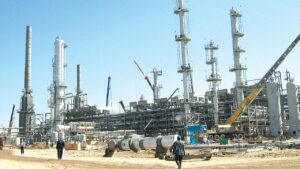Industries In Nigeria SS2 Economics Lesson Note
Download Lesson NoteTopic: Industries In Nigeria
MEANING OF INDUSTRY
An industry consists of a group of firms producing broadly similar commodities. Examples are the shoe industry, the transport industry, the cement industry, etc.
The production side of business activity is referred to as industry. It is a business activity, which is related to the raising, producing, processing or manufacturing of products.
The products are consumer’s goods as well as producer’s goods. Consumer goods are goods, which are used finally by consumers. E.g. Food grains, textiles, cosmetics, VCR, etc. Producer’s goods are the goods used by manufacturers for producing some other goods. E.g. Machinery, tools, equipment, etc.
Expansion of trade and commerce depends on industrial growth. It represents the supply side of the market.
FIRM
The firm is an independently administered business unit carrying out production, construction, or distribution activities. Examples of firms in Nigeria are Dangote Cement and Cadbury Nigeria Plc.
PLANT
This is the same as the factory. It consists of the tools, equipment, machines and buildings of a business concern. It is a business establishment or the actual place where production is organized. E.g Aladja steel plant, etc.
TYPES OF INDUSTRIES
- Primary Industry.
Primary industry is concerned with the production of goods with the help of nature. It is a nature-oriented industry, which requires very little human effort. E.g. Agriculture, farming, forestry, fishing, horticulture, etc.
- Genetic Industry
Genetic industries are engaged in the reproduction and multiplication of certain species of plants and animals with the object of sale. The main aim is to earn profit from such sales. E.g. plant nurseries, cattle rearing, poultry, cattle breeding, etc.
- Extractive Industry
The extractive industry is concerned with extraction or drawing out goods from the soil, air or water. Generally, products of extractive industries come in raw form and they are used by manufacturing and construction industries for producing finished products. E.g. mining industry, coal mineral, oil industry, iron ore, extraction of timber and rubber from forests, etc.
- Manufacturing Industry
Manufacturing industries are engaged in transforming raw materials into finished products with the help of machines and manpower. The finished goods can be either consumer goods or producer goods. E.g. textiles, chemicals, sugar industry, paper industry, etc.
- Construction Industry
Construction industries take up the work of construction of buildings, bridges, roads, dams, canals, etc. This industry is different from all other types of industry because, in the case of other industries, goods can be produced at one place and sold at another place. But goods produced and sold by constructive industry are erected in one place.
- Service Industry
In modern times service sector plays an important role in the development of the nation and therefore it is named as service industry. The main industries, which fall under this category, include the hotel industry, tourism industry, entertainment industry, etc.
LOCATION OF INDUSTRY
Location of industry refers to the siting of an industry in a particular place.
FACTORS INFLUENCING INDUSTRIAL LOCATION
Generally, the location of industries is influenced by economic considerations though certain non-economic considerations also might influence the location of some industries. Maximisation of profit which also implies cost minimization is the most important goal in their choice of particular places for the location of industries. There are several factors which pull the industry to a particular place. Some of the major factors influencing location are discussed below:
- Availability Of Raw Materials: In determining the location of an industry, nearness to sources of raw materials is of vital importance. Nearness to the sources of raw materials would reduce the cost of production of the industry. For most of the major industries, the cost of raw materials forms the bulk of the total cost. Therefore, most of the agro-based and forest-based industries are located in the vicinity of the sources of raw material supply.
- Availability of Labour: An adequate supply of cheap and skilled labour is necessary for an industry. The attraction of an industry towards labour centres depends on the ratio of labour cost to the total cost of production which Weber calls ‘Labour cost of Index’. The availability of skilled workers in the interior parts of the Bombay region was one of the factors responsible for the initial concentration of the cotton textile industry in the region.
- Proximity to Markets: Access to markets is an important factor which the entrepreneur must take into consideration. Industries producing perishable or bulky commodities which cannot be transported over long distances are generally located near markets. Industries located near the markets could be able to reduce the costs of transport in distributing the finished product as in the case of bread and bakery, ice, tins, cans manufacturing, etc. Accessibility of markets is more important in the case of industries manufacturing consumer goods rather than producer goods.
- Transport Facilities: Transport facilities, generally, influence the location of the industry. Transportation with its three modes, i.e., water, road, and rail collectively plays an important role. So the junction points of waterways, roadways and railways become humming centres of industrial activity. Further, the modes and rates of transport and transport policy of the Government considerably affect the location of industrial units. The heavy concentration of the cotton textile industry in Bombay has been due to the cheap and excellent transportation network both regarding raw materials and markets.
- Power: Another factor influencing the location of an industry is the availability of cheap power. Water, wind, coal, gas, oil and electricity are the chief sources of power. Both water and wind power were widely sought as sources of power supply before the invention of the steam engine. During the nineteenth century, nearness to coal fields became the principal locating influence on the setting up of new industries, particularly, for heavy industries. With the introduction of other sources of power like electricity, gas, oil, etc. the power factor became more flexible leading to dispersal and decentralization of industries.
- Site and Services: The existence of public utility services, cheapness of the value of the site, amenities attached to a particular site like level of ground, the nature of vegetation and location of allied activities influence the location of an industry to a certain extent. The government has classified some areas as backward areas where the entrepreneurs would be granted various incentives like subsidies, provision of finance at concessional rates, supply of power a cheaper rates and provision of education and training facilities. Some entrepreneurs induced by such incentives may come forward to locate their units in such areas.
- Finance: Finance is required for the setting up of an industry, for its running, and also at the time of its expansion. The availability of capital at cheap rates of interest and inadequate is a dominating factor influencing industrial location. For instance, a review of the locational history of the Indian cotton textile industry indicates that the concentration of the industry in and around Bombay in the early days was mainly due to the presence of rich and enterprising Parsi and Bhatia merchants, who supplied vast financial resources.
- Natural and Climatic Considerations: Natural and climatic considerations include the level of ground, topography of a region, water facilities, drainage facilities, disposal of waste products, etc. These factors sometimes influence the location of industries. For instance, in the case of the cotton textile industry, a humid climate provides an added advantage since the frequency of yarn breakage is low. The humid climate of Bombay in India and Manchester in Britain offered great scope for the development of the cotton textile industry in those centres.
- Personal Factors: In deciding the location of industrial units, sometimes an entrepreneur may have personal preferences and prejudices against certain localities. For instance, Mr. Ford started to manufacture motor cars in Detroit simply because it was his hometown. In such cases, personal factor dominates other considerations. However, this kind of domination is rare.
- Strategic Considerations: In modern times, strategic considerations play a vital role in determining industrial location. During wartime, a safe location assumes special significance. This is because, in times of war, the main targets of air attacks would be armament and ammunition factories and industries supplying other commodities which are required for war. The Russian experience during the Second World War provides an interesting example.
- External Economies: External economies also exert considerable influence on the location of industries. External economies arise due to the growth of specialized subsidiary activities when a particular industry is mainly localized at a particular centre with port and shipping facilities. External economies could also be enjoyed when a large number of industrial units in the same industry were located near one another.
- Miscellaneous Factors: Historical incidents also play a dominating role in determining the location of industries in certain cases. The development of the cotton textile industry in Lancashire provides an interesting example of this. Further, the size of an industrial unit would also have much influence in choosing a location. This is because the size of industrial units depends upon the radius of the circle within which they can profitably distribute their goods and upon the density of the population living within the circle.
LOCALISATION OF INDUSTRIES
Localisation of industries refers to the concentration of many firms of an industry in a particular area.
ADVANTAGES AND DISADVANTAGES OF LOCALISATION
Localisation has both merits and limits. They are enumerated below.
ADVANTAGES
i. Reputation – The place where an industry is localised gains reputation and so do the products produced there. As a consequence, articles bearing the name of that location find wide markets such as Sheffield cutlery, Swiss watches Ludhiana Hosiery etc.
ii. Skilled Labour – Localisation escorts to specialisation in particular trades. As a consequence, labourers skilled in those trades are fascinated by that place. The localised industry is continuously fed by a regular supply of skilled labour that also attracts new firms into the industry. Further, there is a local supply of skilled labour that children of the labourers accede from them. The enhancements of the watch industry in Switzerland, of the shawl industry in Kashmir etc are primarily due to this factor.
iii. Growth of Facilities – The focus of an industry in a specified region leads to the development of specific facilities there. To cater to the needs of the industry, banks and financial institutions, open their branches whereby the firms can get timely credit facilities. Railways and transport concerns allow exceptional transport facilities which the firms make use of bringing materials and transporting goods. Likewise, insurance companies give insurance facilities and thus indemnify the risk of fire, accidents, thefts etc.
iv. Subsidiary industries – Where industries are localised, subsidiary industries grow up to supply machines, tools, implements and other materials and to utilise their by-products. For instance, where the sugar industry is localised, plants produce sugar machinery tools from molasses and for rearing poultry which utilise molasses in nosh.
v. Employment Opportunities – As an effect of the above, with the localisation of an industry in a particular locality and the establishment of subsidiary industries, employment opportunities considerably increase in that region.
vi. Common Problems – All concerns form an association to solve their common difficulties. This connection secures various types of facilities from the government and other agencies for expanding business establishing research labs, publishing technical and trade journals and opening training centres for technical personnel. As a consequence, all firms benefit.
vii. Economy Gains – Localisation leads to the lowering of production costs and improvement in the quality of the products when the firms benefit from the availability of skilled labour, timely credit, quality materials, research facilities, market and transport facilities etc. Also the trade gains through the standing of the place, the people gain through larger employment opportunities, the government gains through larger tax revenue and thus the economy gains on the whole.
DISADVANTAGES
Also, localisation is not an unmixed go-ahead. It has its limitations.
i. Dependence – When an industry is localised in a particular locality, it makes the economy dependent on its requirements for the products manufactured there. Such dependence is dangerous in the event of war, misery, or a natural disaster since the supplies of the articles will be disturbed and the whole financial system will endure.
ii. Social Problems – Localisation of industries in a particular locality creates many social problems such as congestion, emergence of slums, accidents, strikes etc. These adversely affect the efficiency of labour and the productive ability of the industry.
iii. Limited Employment – Where an industry is localised, employment opportunities are limited to a particular type of labour. In the event of a slump in that industry, specialised labour fails to get surrogate employment in some other place. Once again, if such specialised labour organises itself into a powerful trade union, it can force the employers to pay higher wages which may raise the outlay of manufacture and unfavourably influence the industry.
iv. Diseconomies – With the way of time, and the focus of industries in a meticulous place, economies of scale may give a path to diseconomies. Transport-restricted access emerges. There are recurrent power breakdowns. Financial organizations are powerless to meet the credit needs of the entire industry due to fiscal severity. As noted previously, labour asks for higher wages and better and better living conditions. All these are inclined to raise the costs of production and reduce production.
v. Regional Imbalance – Focus of industries in one region or locality leads to the top-sided development of the fiscal. When one industry is localised in a region it attracts more businessmen who establish other industries there because of the accessibility of infrastructure facilities like power, transport, finance, labour etc. Thus such regions improve more whilst the other areas linger backward. Employment opportunities, the level of earnings and the standard of living amplify at a much greater velocity in these areas relative to other areas of the nation.























